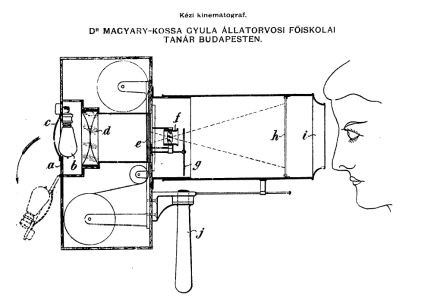
The innovator: Gyula Magyary-Kossa (1865-1944), doctor of medicine, professor of medicine and toxicology from 1896 to 1936, lecturer in veterinary history from 1896 to 1905. In addition to his many important studies in pharmacy and poisoning, the best known of which is the so-called Kossa reaction, he also made a lasting contribution to the history of medicine and veterinary medicine.
(Source: Hungarian Veterinary Pantheon in Hungarian)
Description: “The subject of the present invention is a cinematographic apparatus having the characteristic feature that all the components necessary for the display, namely the light source, the condenser, the film, the objective, the shutter and the projection screen are all arranged in a small enclosed cabinet, which has a window opposite the transparent screen and a hand-held handle at a suitable location, so that the whole apparatus can be conveniently held in the hand.” (Serial No 67699)
(Source: National Intellectual Property Office e-database, where the full text of the patent is freely available. http://epub.hpo.hu/e-nyilvantartas/?lang=HU in Hungarian)
Year: 1914
Interesting: “He also thought a lot about different studies, such as inventing a cinematograph to project still and moving images in a darkened or bright room to make teaching more visual. The prototype was completed, and patents were granted in Hungary and abroad, but the war prevented mass production.” – said his son at a commemoration of the 125th anniversary of Gyula Magyary-Kossa’s birth.
(Source. : Magyary-Kossa Gyula: Apám emlékei (Parerga). Magyar Állatorvosok Lapja, 1990. 45. 8. 494-495.)
Indeed, in 1916, the author published the following advertisement in the pages of the journal Honi ipar (Domestic industry).
“Dr. Gyula Magyary-Kossa, professor at the veterinary college in Budapest, wishes to sell his Hungarian patent No. 67699, entitled “manual cinematograf”, or may possibly grant a manufacturing licence for it.”
(Source: Honi Ipar, 1916. 17. 13. 22.)
Éva Orbán

